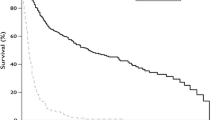Abstract
Chemoradiotherapy (CRT) has evolved as the preferred organ preservation strategy in the treatment of locally advanced head and neck cancer (HNC). This approach increases malnutrition, and thus, establishing a direct enteral feeding route is essential. To evaluate the usefulness of prophylactic percutaneous endoscopic gastrostomy (PEG) in HNC patients receiving definitive CRT, we performed a prospective evaluation of HNC patients over a 6-month period. Patients and tumor characteristics, nutritional status 30 days after PEG insertion and technique complications were evaluated. We also assessed the long-term PEG usage. Forty-seven PEGs were placed and only 2 patients did not use it. The mean time of PEG use was 131 days (4–255) and mean duration of exclusive utilization was 71 days (4–180). On 30th day after procedure, 34/45 (76 %) patients had lost weight, but only 10/45 (22 %) patients had lost more than 10 % of their initial weight. The most frequent complications were minor peristomal infections, which were correlated with proton-pump inhibitor use before PEG placement (OR 3.91, 95 % CI 1.01–15.2, and p = 0.049). One year later, 19 % of patients in remission continue needing PEG. Enteric nutritional support is essential during and after CRT in HNC patients. Most patients lost weight even with PEG. One-fifth of patients in remission required long-term PEG utilization.


Similar content being viewed by others
References
Devlin J, Sherman E. Combined modality treatment of squamous cell cancer of the head and neck. Clin Adv Hematol Oncol. 2005;3(5):373–82.
Chan A, Grégoire V, Lefebvre JL, Licitra L, Hui EP, Leung SF, Felip E. Nasopharyngeal cancer: EHNS-ESMO-ESTRO clinical practice guidelines for diagnosis, treatment and follow-up. Ann Oncol. 2012;23(Suppl. 7):vii83–5.
Marcy PY, Magné N, Bensadoun RJ, et al. Systematic percutaneous fluoroscopy gastrostomy for concomitant radiochemotherapy of advanced head and neck cancer; optimisation of therapy. Support Care Cancer. 2000;8:410–3.
Murphy B, Gilbert J. Dysphagia in head and neck cancer patients treated with radiation: assessment, sequelae and rehabilitation. Semin Radiat Oncol. 2009;19(1):35–42.
Cheng S, Terrell J, Bradford CR, et al. Variables associated with feeding tube placement in head and neck cancer. Arch Otolaryngol Head Neck Surg. 2006;132(6):655–61.
Nugent B, Lewis S, O’Sullivan JM. Enteral feeding methods for nutritional management in patients with head and neck cancers being treated with radiotherapy and/or chemotherapy. Cochrane Database Syst. 2010;17(3):CD007909.
Wang J, Liu M, Liu C, Ye Y, Huang G. Percutaneous endoscopic gastrostomy versus nasogastric tube feeding for patients with head and neck cancer: a systematic review. J Radiat Res. 2014;55(3):559–67.
Ponsky J, Gauderer M. Percutaneous endoscopic gastrostomy: a nonoperative technique for feeding gastrostomy. Gastrointest Endosc. 1981;27(1):9–11.
Cravo M, Glória L, Claro I. Metabolic responses to tumour disease and progression: tumour-host interaction. Clin Nutr. 2000;19(6):459–65.
Forastiere A, Goepfert H, Maor M, et al. Concurrent chemotherapy and radiotherapy for organ preservation in advanced laryngeal cancer. N Engl J Med. 2003;349:2091–8.
Pignon J, Maitre A, Maillard E, Bourhis J. Meta-analysis of chemotherapy in head and neck cancer (MACH-NC): an update on 93 randomized trials and 17,346 patients. Radiother Oncol. 2009;92:4–14.
Capuano G, Grosso A, Gentile PC, et al. Influence of weight loss on outcomes in patients with head and neck cancer undergoing concomitant chemoradiotherapy. Head Neck. 2008;30:503–8.
Berg MG, Rasmussen-Conrad E, Nispen L, Binsbergen JJ, Merkx MA. A prospective study on malnutrition and quality of life in patients with head and neck cancer. Oral Oncol. 2008;44(9):830–7.
Bokhorst S, Leeuwen P, Leeuwen PA, et al. The impact of nutritional status on the prognoses of patients with advanced head and neck cancer. Cancer. 1999;86(3):519–27.
Piquet M, Ozsahin M, Larpin I, et al. Early nutritional intervention in oropharyngeal cancer patients undergoing radiotherapy. Support Care Cancer. 2002;10(6):502–4.
Mohammad M, Blankenship M, Blankenship DM, Krempl GA, Tierney WM. Prophylactic PEG placement in head and neck cancer: how many feeding tubes are unused (and unnecessary)? World J Gastroenterol. 2011;17(8):1004–8.
Wermker K, Jung S, Hüppmeier L, Joos U, Kleinheinz J. Prediction model for early percutaneous endoscopic gastrostomy (PEG) in head and neck cancer treatment. Oral Oncol. 2012;48(4):355–60.
Munshi A, Pandey M, Durga T, Pandey KC, Bahadur S, Mohanti BK. Weight loss during radiotherapy for head and neck malignances: what factors impact it? Nutr Cancer. 2003;47(2):136–40.
Newman L, Vieira F, Schwiezer V, et al. Eating and weight changes following chemoradiation therapy for advanced head and neck cancer. Arch Otolaryngol. 1998;124(5):589–92.
Paccagnella A, Morello M, Mosto MC, et al. Early nutrition intervention improves treatment tolerance and outcomes in head and neck cancer patients undergoing concurrent chemoradiotherapy. Support Care Cancer. 2009;18(7):837–45.
Corry J, Poom W, McPhee N, et al. Prospective study of percutaneous endoscopic gastrostomy tubes versus nasogastric tubes for enteral feeding in patients with head and neck cancer undergoing (chemo) radiation. Head Neck. 2009;31(7):867–76.
Hiroto I, Onozawa Y, Takashi K, et al. Nutrition support for head and neck squamous cell carcinoma patients treated with chemoradiotherapy: how often and how long? ISRN Oncol. 2012;2012:274–739.
Grant D, Bradley P, Pothier DD, et al. Complications following gastrostomy tube insertion in patients with head and neck cancer: a prospective multi-instituion, systematic review and meta-analysis. Clin Otolaryngol. 2009;34(2):103–12.
Pil Im J, Myung Cha J, Kim JW, et al. Proton pump inhibitor use before percutaneous endoscopic gastrostomy is associated with adverse outcomes. Gut Liver. 2014;8(3):248–53.
Handa O, Yoshida N, Fujita N, et al. Molecular mechanisms involved in anti-inflammatory effects of proton pump inhibitors. Inflamm Res. 2006;55(11):476–80.
Hopkins A, McDonnell C, Breslin NP, O’Morain CA, Baird AW. Omeprazole increases permeability across isolated rat gastric mucosa pre-treated with an acid secretagogue. J Pharm Pharmacol. 2002;54(3):341–7.
Lewis S, Franco S, Young G, O’Keefe SJ. Altered bowel function and duodenal bacterial overgrowth in patients treated with omeprazole. Aliment Pharmacol Ther. 1996;10(4):557–61.
Author information
Authors and Affiliations
Corresponding author
Ethics declarations
Conflict of interest
None of the authors has any relevant conflict of interest to disclose.
Rights and permissions
About this article
Cite this article
Moleiro, J., Faias, S., Fidalgo, C. et al. Usefulness of Prophylactic Percutaneous Gastrostomy Placement in Patients with Head and Neck Cancer Treated with Chemoradiotherapy. Dysphagia 31, 84–89 (2016). https://doi.org/10.1007/s00455-015-9661-y
Received:
Accepted:
Published:
Issue Date:
DOI: https://doi.org/10.1007/s00455-015-9661-y




